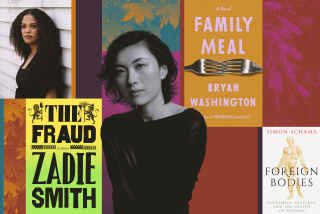Discoveries: ‘Shoplifting From American Apparel’
Shoplifting From
American Apparel
A Novella
Tao Lin
Melville House: 104 pp., $13 paper
It’s easy to be skeptical. There’s little character development, less plot and scrawny dialogue. Landscape? The warm blue glow of Internet Explorer, the NYU campus and a couple of jail cells. Voice of the future? Don’t think so. “I think we are going insane,” Luis e-mails Sam. “From not being around people. We are starting to go inside ourselves, and play around inside of our own mental illness. That doesn’t make any sense.”
Sam is a writer. His new book is doing pretty well (30,000 copies sold on Amazon). On the way to a reading he steals a shirt from American Apparel, almost as if he’s trying to make something happen in his life. Anything. Somehow, he mixes up the idea of shoplifting with the idea of Robin Hood; stealing from the rich (American Apparel) to clothe the poor (himself). Somewhere in his mind the idea of the outsider artist crouches. It’s a given that as a writer he should and will be poor, marginalized, cool. His frames of reference: Ha Jin, Stephen Dixon, Bret Easton Ellis, Lorrie Moore. Sam refers to these authors and their books in a strange, slight, offhand way, as one would a coffee table or a new pair of shoes. You don’t think, “I like this guy,” or “I really dislike this guy.” You think, “huh.” You kind of admire the way he doesn’t overreact. But you are frightened by how completely he accepts whatever happens to him as the fresh screen in his life. You feel sad for him -- his relationships are so awkward and don’t produce any jolt of joy. Are you thinking Camus’ “The Stranger” or “sociopath”?
Tao Lin is 26, the son of Taiwanese immigrants. While studying journalism and creative writing at NYU he started a blog, Reader of Depressing Books. He’s written two books of poetry, a collection of stories and a novel, “Eeeee Eee Eeee.” I’m curious to see what you think.
Gourmet Rhapsody
A Novel
Muriel Barbery, translated from
the French by Alison Anderson
Europa Editions: 156 pp., $15 paper
“I am the greatest food critic in the world,” thinks 68-year-old Pierre Arthens, just 48 hours from death. “It is I who has taken this minor art and raised it to a rank of utmost prestige. Everyone knows my name, from Paris to Rio, Moscow to Brazzaville, Saigon to Melbourne and Acapulco.” Yup, he’s insufferable, and yet there are those who love him. We see Pierre from all angles; his wife and three children; his beloved nephew; his concierge, his dog. These myriad impressions are what he leaves behind. “His prose . . . his prose was nectar, ambrosia, a hymn to language: it was gut-wrenching, and it hardly mattered whether he was talking about food or something else.” Pierre remembers the tastes of his childhood; of Tangier and Rabat. He remembers his grandmother’s cooking, his Aunt Marthe’s garden, a true American breakfast he had in a San Francisco diner. He longs for a particular flavor. He can’t think what it is -- until his very last moments. A pastry -- chouquettes -- complex and unique and rare in the way that only simple foods can be. Pierre is the Grinch. His heart is three sizes too small: “I am an encyclopedic esthete,” he confesses, “who is always one dish ahead of the game -- but always one heart behind.”
Journal of a Prairie Year
Paul Gruchow
Milkweed Editions: 138 pp., $14 paper
Paul Gruchow’s “Journal of a Prairie Year” was first published in 1985. In a new foreword, Scott Russell Sanders writes that this form, a seasonal cycle of a carefully watched environment, gives structure to some of our finest, most observant nature writing, including Thoreau’s “Walden” and Aldo Leopold’s “A Sand County Almanac.” Gruchow writes of the glare of moonlight on snow; of the impulse to name and possess things in the natural world; of prairie phlox, garter snakes and the dust in the air that turns the sunlight crimson. Mostly colors, but also changes in light, the feel of the wind -- an alertness permeates this enduring book:
“The color of the sky deepened as the black hulk of the thundercloud took dominion over the landscape. It turned a brilliant Dresden blue, and against it the shiny unmoving leaves of the cottonwoods emitted an unearthly green glow, like that of the satin leaves of fairy-tale trees. The intensity of the colors magnified the stillness that had fallen over the land.”
More to Read
The biggest entertainment stories
Get our big stories about Hollywood, film, television, music, arts, culture and more right in your inbox as soon as they publish.
You may occasionally receive promotional content from the Los Angeles Times.








